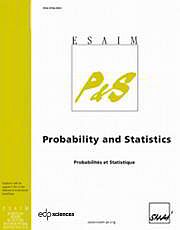Crossref Citations
This article has been cited by the following publications. This list is generated based on data provided by
Crossref.
Benaïm, Michel
and
Cloez, Bertrand
2015.
A stochastic approximation approach to quasi-stationary
distributions on finite spaces.
Electronic Communications in Probability,
Vol. 20,
Issue. none,
Villemonais, Denis
2015.
Minimal quasi-stationary distribution approximation for a birth and death process.
Electronic Journal of Probability,
Vol. 20,
Issue. none,
Champagnat, Nicolas
and
Villemonais, Denis
2016.
Exponential convergence to quasi-stationary distribution and $$Q$$-process.
Probability Theory and Related Fields,
Vol. 164,
Issue. 1-2,
p.
243.
Coron, Camille
2016.
Slow-fast stochastic diffusion dynamics and quasi-stationarity for diploid populations with varying size.
Journal of Mathematical Biology,
Vol. 72,
Issue. 1-2,
p.
171.
Oçafrain, William
and
Villemonais, Denis
2017.
Convergence of a non-failable mean-field particle system.
Stochastic Analysis and Applications,
Vol. 35,
Issue. 4,
p.
587.
Benaim, Michel
Cloez, Bertrand
and
Panloup, Fabien
2018.
Stochastic approximation of quasi-stationary distributions on compact spaces and applications.
The Annals of Applied Probability,
Vol. 28,
Issue. 4,
Bieniek, Mariusz
and
Burdzy, Krzysztof
2018.
The distribution of the spine of a Fleming–Viot type process.
Stochastic Processes and their Applications,
Vol. 128,
Issue. 11,
p.
3751.
Del Moral, Pierre
and
Villemonais, Denis
2018.
Exponential mixing properties for time inhomogeneous diffusion processes with killing.
Bernoulli,
Vol. 24,
Issue. 2,
Champagnat, Nicolas
and
Villemonais, Denis
2019.
Convergence of the Fleming-Viot process toward the minimal quasi-stationary distribution
.
Latin American Journal of Probability and Mathematical Statistics,
Vol. 16,
Issue. 2,
p.
1263.
Arnaudon, Marc
and
Del Moral, Pierre
2020.
A duality formula and a particle Gibbs sampler for continuous time Feynman-Kac measures on path spaces.
Electronic Journal of Probability,
Vol. 25,
Issue. none,
Cérou, Frédéric
Delyon, Bernard
Guyader, Arnaud
and
Rousset, Mathias
2020.
A central limit theorem for Fleming–Viot particle systems.
Annales de l'Institut Henri Poincaré, Probabilités et Statistiques,
Vol. 56,
Issue. 1,
Villemonais, Denis
2020.
Lower Bound for the Coarse Ricci Curvature of Continuous-Time Pure-Jump Processes.
Journal of Theoretical Probability,
Vol. 33,
Issue. 2,
p.
954.
Champagnat, Nicolas
and
Villemonais, Denis
2021.
Convergence of the Fleming-Viot process toward the minimal quasi-stationary distribution
.
Latin American Journal of Probability and Mathematical Statistics,
Vol. 18,
Issue. 1,
p.
1.
Corujo, Josué
2021.
Dynamics of a Fleming–Viot type particle system on the cycle graph.
Stochastic Processes and their Applications,
Vol. 136,
Issue. ,
p.
57.
Champagnat, Nicolas
Schott, René
and
Villemonais, Denis
2021.
Analysis of distributed systems via quasi-stationary distributions.
Stochastic Analysis and Applications,
Vol. 39,
Issue. 6,
p.
981.
Tough, Oliver
2022.
Stochastic approximation of the paths of killed Markov processes conditioned on survival.
Electronic Communications in Probability,
Vol. 27,
Issue. none,
Budhiraja, Amarjit
Fraiman, Nicolas
and
Waterbury, Adam
2022.
Approximating quasi-stationary distributions with interacting reinforced random walks.
ESAIM: Probability and Statistics,
Vol. 26,
Issue. ,
p.
69.
Cloez, Bertrand
and
Corujo, Josué
2022.
Uniform in time propagation of chaos for a Moran model.
Stochastic Processes and their Applications,
Vol. 154,
Issue. ,
p.
251.
Tough, Oliver
and
Nolen, James
2022.
The Fleming-Viot process with McKean-Vlasov dynamics.
Electronic Journal of Probability,
Vol. 27,
Issue. none,
Journel, Lucas
and
Monmarché, Pierre
2022.
Convergence of a particle approximation for the quasi-stationary distribution of a diffusion process: Uniform estimates in a compact soft case.
ESAIM: Probability and Statistics,
Vol. 26,
Issue. ,
p.
1.


